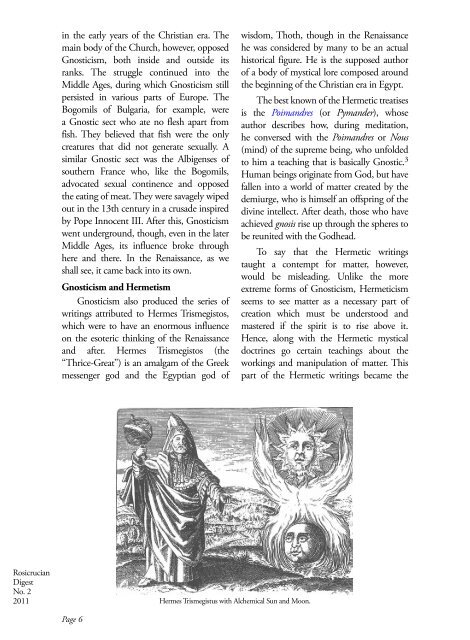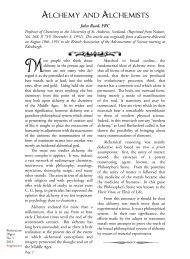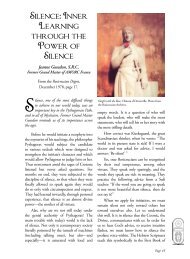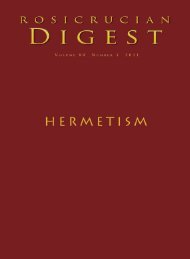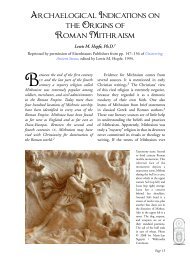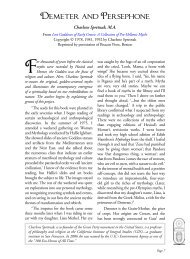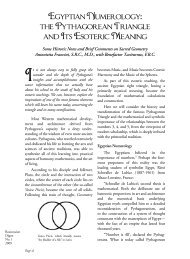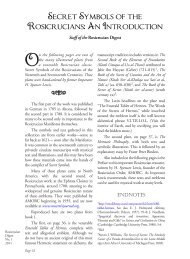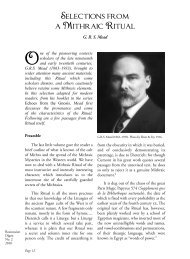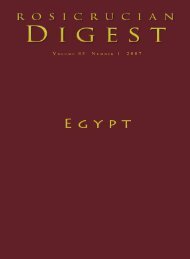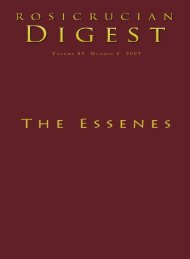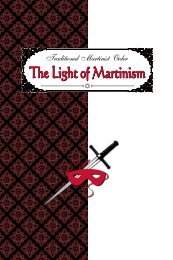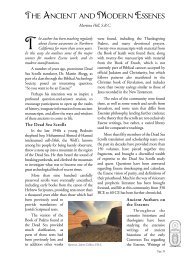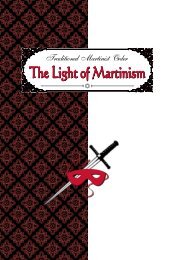Rosicrucian Digest Vol 89 No 2 2011 Gnosticism - Rosicrucian Order
Rosicrucian Digest Vol 89 No 2 2011 Gnosticism - Rosicrucian Order
Rosicrucian Digest Vol 89 No 2 2011 Gnosticism - Rosicrucian Order
You also want an ePaper? Increase the reach of your titles
YUMPU automatically turns print PDFs into web optimized ePapers that Google loves.
in the early years of the Christian era. The<br />
main body of the Church, however, opposed<br />
<strong>Gnosticism</strong>, both inside and outside its<br />
ranks. The struggle continued into the<br />
Middle Ages, during which <strong>Gnosticism</strong> still<br />
persisted in various parts of Europe. The<br />
Bogomils of Bulgaria, for example, were<br />
a Gnostic sect who ate no flesh apart from<br />
fish. They believed that fish were the only<br />
creatures that did not generate sexually. A<br />
similar Gnostic sect was the Albigenses of<br />
southern France who, like the Bogomils,<br />
advocated sexual continence and opposed<br />
the eating of meat. They were savagely wiped<br />
out in the 13th century in a crusade inspired<br />
by Pope Innocent III. After this, <strong>Gnosticism</strong><br />
went underground, though, even in the later<br />
Middle Ages, its influence broke through<br />
here and there. In the Renaissance, as we<br />
shall see, it came back into its own.<br />
<strong>Gnosticism</strong> and Hermetism<br />
<strong>Gnosticism</strong> also produced the series of<br />
writings attributed to Hermes Trismegistos,<br />
which were to have an enormous influence<br />
on the esoteric thinking of the Renaissance<br />
and after. Hermes Trismegistos (the<br />
“Thrice-Great”) is an amalgam of the Greek<br />
messenger god and the Egyptian god of<br />
wisdom, Thoth, though in the Renaissance<br />
he was considered by many to be an actual<br />
historical figure. He is the supposed author<br />
of a body of mystical lore composed around<br />
the beginning of the Christian era in Egypt.<br />
The best known of the Hermetic treatises<br />
is the Poimandres (or Pymander), whose<br />
author describes how, during meditation,<br />
he conversed with the Poimandres or <strong>No</strong>us<br />
(mind) of the supreme being, who unfolded<br />
to him a teaching that is basically Gnostic. 3<br />
Human beings originate from God, but have<br />
fallen into a world of matter created by the<br />
demiurge, who is himself an offspring of the<br />
divine intellect. After death, those who have<br />
achieved gnosis rise up through the spheres to<br />
be reunited with the Godhead.<br />
To say that the Hermetic writings<br />
taught a contempt for matter, however,<br />
would be misleading. Unlike the more<br />
extreme forms of <strong>Gnosticism</strong>, Hermeticism<br />
seems to see matter as a necessary part of<br />
creation which must be understood and<br />
mastered if the spirit is to rise above it.<br />
Hence, along with the Hermetic mystical<br />
doctrines go certain teachings about the<br />
workings and manipulation of matter. This<br />
part of the Hermetic writings became the<br />
<strong>Rosicrucian</strong><br />
<strong>Digest</strong><br />
<strong>No</strong>. 2<br />
<strong>2011</strong><br />
Hermes Trismegistus with Alchemical Sun and Moon.<br />
Page 6


